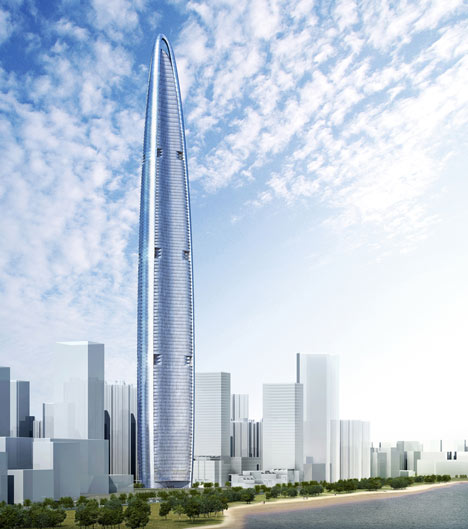
Adrian Smith + Gordon Gill Architecture to design world's fourth-tallest building
Dezeen Wire: Chicago firm Adrian Smith + Gordon Gill Architecture have won a competition to design the Wuhan Greenland Center in Hubei province, China, which is set to be the world's fourth-tallest building.

Construction of the 606-metre tower is due to begin this year and is expected to take five years.
Here are some more details from the architects:
Adrian Smith + Gordon Gill Architecture is pleased to announce that it has won an international competition to design Wuhan Greenland Center, which at 606 meters (1,988 feet) will likely be China’s third-tallest building, and the fourth tallest in the world, when completed in about five years. Construction is scheduled to begin this summer in Wuhan near the meeting of the Yangtze and Han rivers.
A project of the Shanghai-based Greenland Group, the 119-level Wuhan Greenland Center will be comprised of about 300,000 square meters of floor area, including about 200,000 sm of offices, 50,000 sm of luxury apartments and condominiums, a 45,000 sm five-star hotel, and a 5,000 sm, 27-meter-tall private club with spectacular views at the tower’s penthouse level.
AS+GG is leading an interdisciplinary design team that also includes the structural engineering firm Thornton Tomasetti as well as PositivEnergy Practice, an energy services, engineering and consulting company. The other finalists in the design competition were the Chicago office of Skidmore, Owings & Merrill; HOK Architects; GMP Architects; and P&T Architects.
The project reunites the Greenland Group with Adrian Smith and Gordon Gill, who designed the Nanjing Greenland Financial Center, and Robert Forest, who managed the Nanjing design process, all while at SOM. Nanjing Greenland Financial Center’s Zifeng Tower, currently the world’s seventh-tallest building at 450 meters (1,476 feet), opened last fall.
“We’re thrilled to be working with the Greenland Group once again,” Adrian Smith said. “We had a very good experience on the Nanjing project, and we think Wuhan promises to be just as rewarding. As always, we’re extremely impressed with Greenland’s commitment to good design and quality construction. ”
“Wuhan is an exciting and important project for our firm as we continue to advance our ideas about performance-based supertall tower design,” added Gordon Gill. “We look forward to building on past experience on similar projects, with particular emphasis on the relation of architectural form and performance as they pertain to structural wind loads. It’s very rewarding to be working with the Greenland team. We enjoyed our time on Nanjing and look forward to creating a world-class project with them for Wuhan.”
Still under design, Wuhan Greenland Center features a uniquely streamlined form that combines three key shaping concepts—a tapered body, softly rounded corners and a domed top—to reduce wind resistance and vortex action that builds up around supertall towers. The building’s extremely efficient aerodynamic performance will allow it to minimize the amount of structural material (and its associated embodied carbon) needed for construction.
The tower’s three corners rise from its tripod-shaped base and taper upward, culminating in an arched tip above the dome at the top. The corners will be of smooth curved glass, contrasting markedly with the more textured curtain wall cladding the body of the tower. The curtain wall will enclose a composite concrete core with steel framing. Apertures in the curtain wall at regular intervals will assist in venting wind pressure against the tower; the apertures will also house window-washing systems and air intake and exhaust systems on mechanical floors.
“One of the distinctive features of this project is the innovative introduction of vents at the tips of the three legs of the tower at vertical quarter sections that will reduce wind pressure on the tower and reduce the vortices that can cause horizontal acceleration of movement,” Smith said. “This feature, along with the elegant tapering of the tower, is an essential element in this performative design concept.”
“It’s an honor to be working with Greenland Group again on such a significant project,” AS+GG partner Robert Forest added. “Wuhan Greenland Center continues our commitment to providing designs that enhance China’s ability to provide for an increasing population density while striving to reduce energy use and carbon emissions without compromising design quality, performance and cost.”
Other planned sustainable elements of the project include:
- Energy recovery using an enthalpy wheel integrated into the ventilation system; this captures energy from the building’s exhaust systems and uses it to pre-heat or pre-cool air entering the building.
- A greywater recovery system, which takes waste water from the hotel laundry, sinks and showers and reuses it in the building’s evaporative cooling system.
- A high-efficiency lighting system, which uses low-energy-consuming ballasts and lamps to reduce required power consumption.
- A daylight-responsive control system, which automatically turns off electric lights when sufficient daylight is available.
- Water-conserving low-flow plumbing fixtures, which reduce the total amount of potable water required as well as the associated pumping energy.
In addition, the AS+GG Interiors studio is developing the tower’s fluidly sculpted interior public spaces, many of which reflect the tower’s exterior silhouette. The conical silhouette is visibly echoed in the entrances to the primary elevator bank from the main lobby, as well as in the shapes of the elevator cabs and other public spaces. The lobbies and other amenity spaces within the tower also feature sweeping, fluid lines and a neutral blue-gray palette that recalls the reflective glass of the exterior wall. The transparency of the ground-floor lobby wall allows views from inside toward the entry canopy drop-off areas, establishing a seamless relationship between the interior and exterior.

Back to Dezeen Wire »
Back to Dezeen »